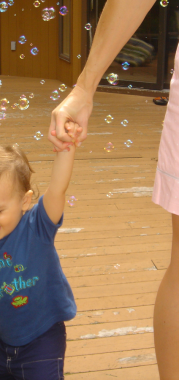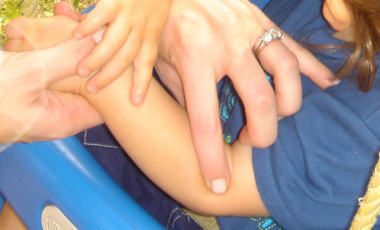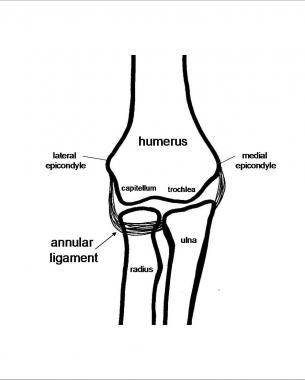

Radial head subluxation, also known as pulled elbow or nursemaid’s elbow, is the most common upper-extremity injury in infants and young children who present to the emergency department (ED). Reduction of the subluxated radial head is easily performed in the ED, and complications are rare.
Subluxation of the radial head is a minor soft-tissue injury that has a peak incidence in children aged 2-3 years and generally affects children younger than 6 years.[1] Although occurrence outside this population is uncommon, radial head subluxation does occur in patients younger than 6 months, as well as in older children and even adults.[2]
Subluxation of the radial head typically results from a quick pull on a child’s arm (see the image below).[3] Often, this occurs when a child is holding hands with a caregiver who lifts the child by the arm or tries to prevent a fall. Parents therefore may provide a history of a fall preceding the injury. Frequently, however, caregivers are unsure what caused the injury because the causative mechanical force can be minor or even trivial.[4] Rarely, underlying musculoskeletal abnormalities may precipitate a subluxation.[5]
 Subluxation of radial head occurs after longitudinal traction is placed on pronated extended arm.
Next
Subluxation of radial head occurs after longitudinal traction is placed on pronated extended arm.
Next
Joint reduction is indicated for diagnosed radial head subluxation. The diagnosis is mostly supported by the finding of a child holding the elbow slightly flexed and pronated, with a lack of ecchymosis, significant tenderness, or edema in the affected joint. Whenever an injured child presents for care, the physician must consider possible abuse, though this specific injury occurs via a very low force mechanism that is not in itself suggestive of abusive behavior.
A diagnosis other than radial head subluxation should be sought if the history includes trauma to the arm, swelling, significant tenderness, deformity, or ecchymosis to the patient’s elbow (see the image below).
 Alternative diagnoses to radial head subluxation should be sought if point tenderness or any obvious deformity is present.
Alternative diagnoses to radial head subluxation should be sought if point tenderness or any obvious deformity is present.
Furthermore, older children and adults should undergo radiography to evaluate for fracture. In particular, an associated ulnar fracture known as the Monteggia fracture-dislocation should be considered in these older individuals. This injury is diagnosed by means of plain radiography and must be treated with surgical reduction.
Patients with known congenital lesions or neurologic deficits require a more detailed evaluation.
In maturity, the annular ligament encircles and supplies stability to the radial head (see the image below). In children, this ligament is not completely fused and thus is generally weak. Accordingly, when longitudinal axial traction is placed on a child’s extended pronated arm, the radial head may slip or tear through the weak annular ligament into the radiocapitellar articulation.[6] This results in entrapment of the annular ligament and subluxation (or partial dislocation) of the radial head.
 Elbow anatomy with annular ligament.
Elbow anatomy with annular ligament.
The left arm is more commonly involved, presumably because most caretakers are right-handed. Cases in which both elbows are subluxed at the same time have been reported.[7] Girls tend to be affected more often than boys are. Patients with prior radial head fractures are at risk for progressive radial head subluxation.[8]
As many as 27% of patients with radial head subluxation who are treated with joint reduction experience recurrence. Specialists may recommend temporary immobilization or bracing. Fractures are a rare complication of reduction. Infrequently, operative repair is required for subluxations. In rare cases, subluxation may lead to osteochondritis dissecans of the radial head.[9]
Periprocedural Care
Copyright © www.orthopaedics.win Bone Health All Rights Reserved